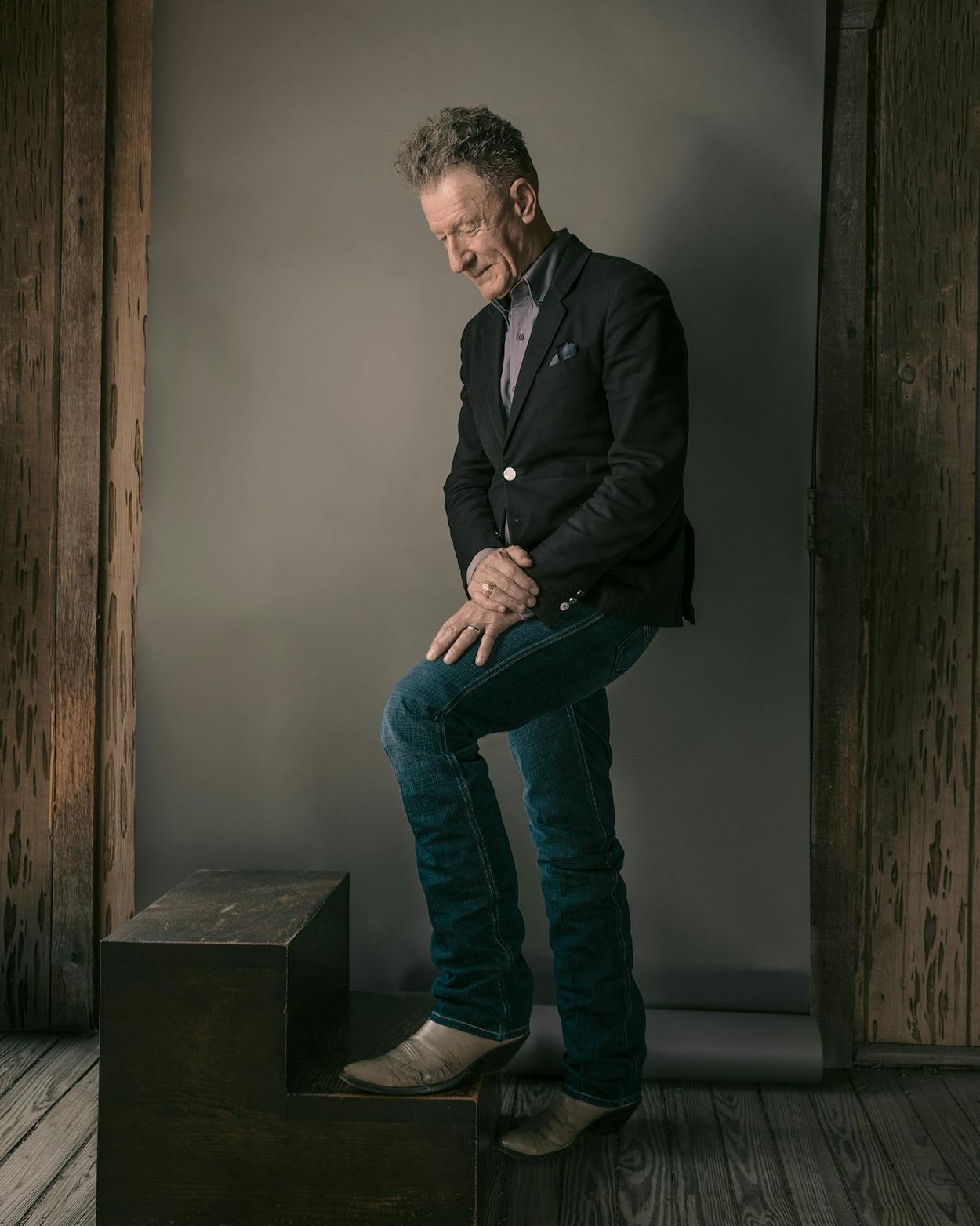Lyle Lovett
The Connoisseur
At this point in his career, Lyle Lovett’s deftness in doling out dry wit has arguably surpassed his triple-stacked curls as his primary calling card. But the Klein native takes the subject of cowboy boots quite seriously. One of the most revered singer-songwriters Texas has produced, Lovett has a deep appreciation for the craft of making boots and the art of wearing them well.
I started wearing boots consistently when I went to college. You get to A&M and see guys that have a certain, very consistent look. For me, it was one less fashion variable to have to think about.
But there have always been a few general rules when it comes to boots. First, wear your pants long enough. Real cowboys have a stacked effect with their jeans. When they rest on the foot of the boot, they kind of wrinkle up. That way, if you’re in the saddle, they’re still long enough. If you see somebody whose pants aren’t long enough, it might be a tell that it’s their first pair of boots.
If you’re wearing a black hat, you wear black boots. Your belt should match your boots and your hat.
And I wouldn’t wear a pair of python boots to church. I wear boots that would be the equivalent of a dress shoe. That’s just common sense.
Guy Clark first took me over to Texas Traditions, in Austin, in 1985. It was the legendary bootmaker Charlie Dunn’s shop. Charlie worked at Capitol Saddlery before opening his own place. Lee and Carrlyn Miller, who own Texas Traditions now, met while working for Charlie. Charlie was famous for firing people, so I asked Lee one day, “How did you survive Charlie? How did Charlie never fire you?” And Lee said, “Oh, Charlie fired me every day. I just kept coming back.”
Lee and Carrlyn made me my first pair of custom boots in 1989. They were a pair of bone kangaroo-skin boots with a twelve-inch top and a half-inch box toe. Before that, I grew up wearing Tony Lama and Justin Boots, until I finally graduated to a pair of Luccheses. By my front door I keep a pair of off-the-shelf Lucchese ropers. They’re really easy to slip in and out of, so I wear them to go to the trash can or get the newspaper.
My favorite pair my wife, April, made for me for my birthday in 1998. They have white tops and black lowers. Lee and Carrlyn tried to direct April to a bone top, something not quite as contrasty as stark white. They do a great job of guiding their customers. But April stuck to her guns. I wore that original pair of black-and-whites to every show for twenty years. Two or three years ago we made an identical pair, which I wear now. I wear them because I love them. But also I love that April gave them to me and they were her idea. That means something.
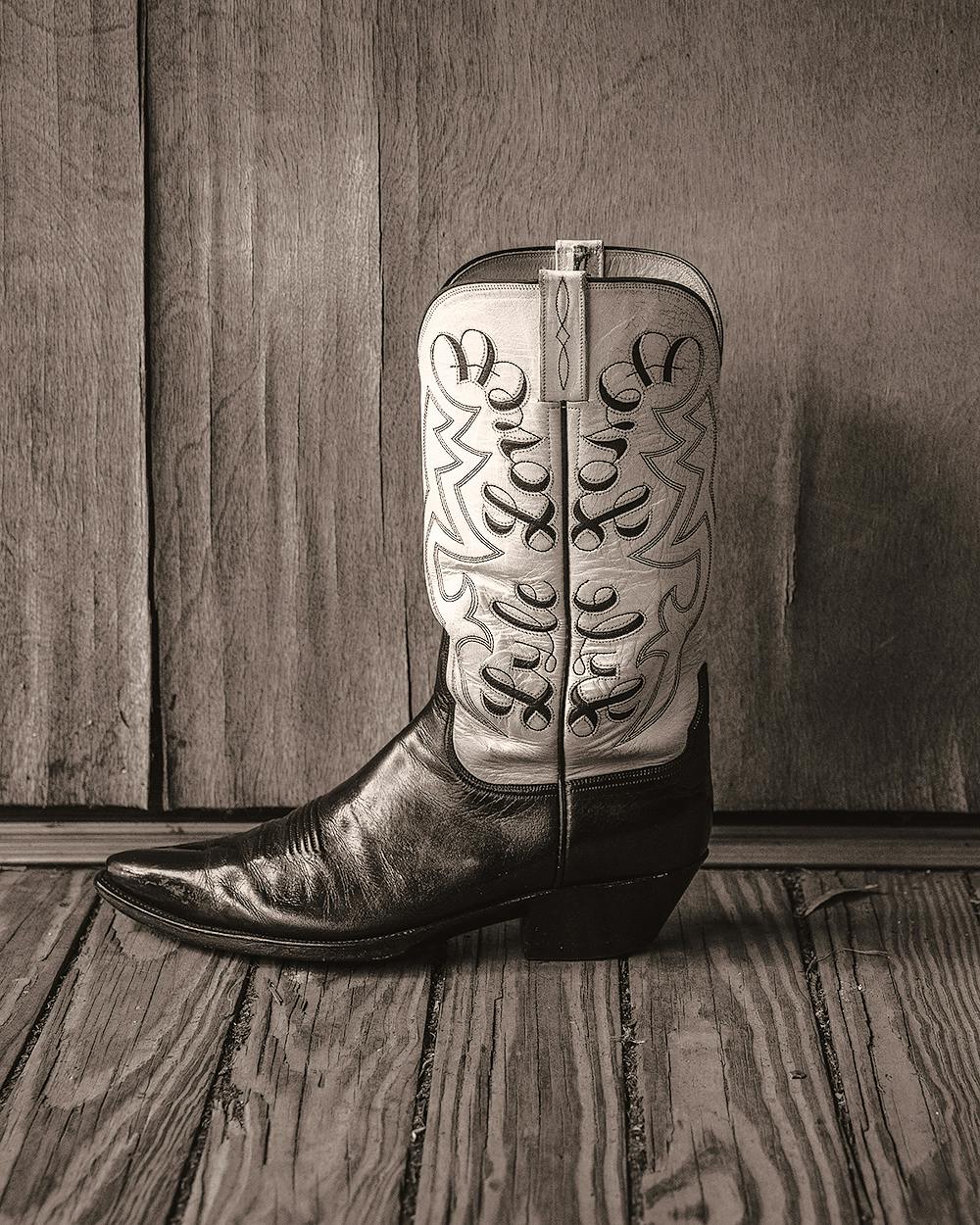
With boots, there are a million design choices, and those choices can define who you are. Different activities require different kinds of boots. I mainly wear a style that would be considered a dress boot, but if I’m home on the farm or going to a horse show, I’ll wear boots that are really functional—tough enough for being knocked around all day in the pasture.
So much comes down to color and the type of skin. A nicely finished cowhide or kangaroo, something that takes a really nice shine, always dresses up whatever you’re wearing. With jeans, you can more easily wear an exotic skin that might make a bolder statement. Alligator always makes for a beautiful dress boot but looks great with jeans too.
A work boot needn’t be a crude piece of work. There are really nice leathers that are extremely durable. Like ostrich. It’s soft and comfortable but tough at the same time. I wear a pair of black tall-top ostrich boots around the farm.
If I wear a pair of boots that get muddy enough that I’m worrying about dirt working its way in and eroding the leather, I will simply hose them off at the end of the day and let them dry really well overnight. Then I wipe them off and condition them with a non-oil cream.
There’s no such thing as an out-of-style boot. There’s an era for that style, and it can be fun to go back, especially if you understand the tradition.
Real cowboys haven’t worn pointed-toe boots like mine since the fifties or sixties. In the seventies, a round-toe boot became fashionable. The last twenty years, it’s gone from a blunt round toe, among the horse folks that I associate with, to a really square toe. So if I’m around real cowboys with my half-inch-box-toe, fifties-throwback sort of dress boots, they ask me if I’ve been hanging out in Hollywood and tease me about it. But if you’re a musician or you do something unconventional for a living, you get forgiven for a lot. They assume you just don’t know any better.
Typically, the fanciest part of the boot is the top, but if you wear your pant leg over it, it’s like you’re not showing off. And it’s fun to be able to reveal the top of your boots to somebody that might be interested. Somebody says, “Oh, those are nice boots!” and then you show them the tops. It’s the next level of the conversation.
I once took Lauren Bacall to Texas Traditions. I got to know her on the Robert Altman film Prêt-à-Porter. She was a big fan of nice footwear. In 2005 she told me she was going to be in Austin for the Texas Film Hall of Fame, so I drove over from Klein, picked her up at the Four Seasons, and took her to Artz Rib House. She had a Pekingese in her purse and was feeding it under the table. Then we went to Texas Traditions and got her measured up for some boots. She wound up with beautiful black ones with the old Charlie Dunn pinched-rose pattern on the tops, with a roper heel.
Boots become part of your life. The little nicks and scratches that you get on them really endear them to you. You remember what you were doing when you marked ’em up. Those little nicks are character builders. They are your life.
In 2002, when my leg was broken by our bull, the paramedics couldn’t have been nicer. They wanted to cut off my boot. And we all knew my leg was broken, but I had the clarity of mind enough to say, “Hey, don’t cut off my boot.” They wiggled it off. I’m glad they could save them.
Tourists to Texas who buy a pair of boots, I wonder how often those boots actually get worn. But I think it says a lot about our culture and about our identity down here that somebody from somewhere else would want to take a little bit of that home with them. I’m not going to judge that. You might be able to laugh a little, good-naturedly, the first time they trip over themselves. But I think we should be flattered. If I maybe saw somebody like that, I’d thank them. And I’d say something like “Nice boots!” and let them figure out what that meant.
With a boot, you’re sending a message. Fashion is all about communication. You’re saying, “This is who I am. This is what I think is important.” If you dress in an innocuous way, maybe you’re saying, “I just want to fit in.” But if you’re stepping onstage and into a white light and everybody’s looking at you anyway, what is it that you want to say about yourself? For me, I’m just trying to communicate who I feel like I am. I’m not trying to assume a character. By wearing boots, I’m just trying to say, “This is where I come from. I’m from Texas.” —As told to Andy Langer
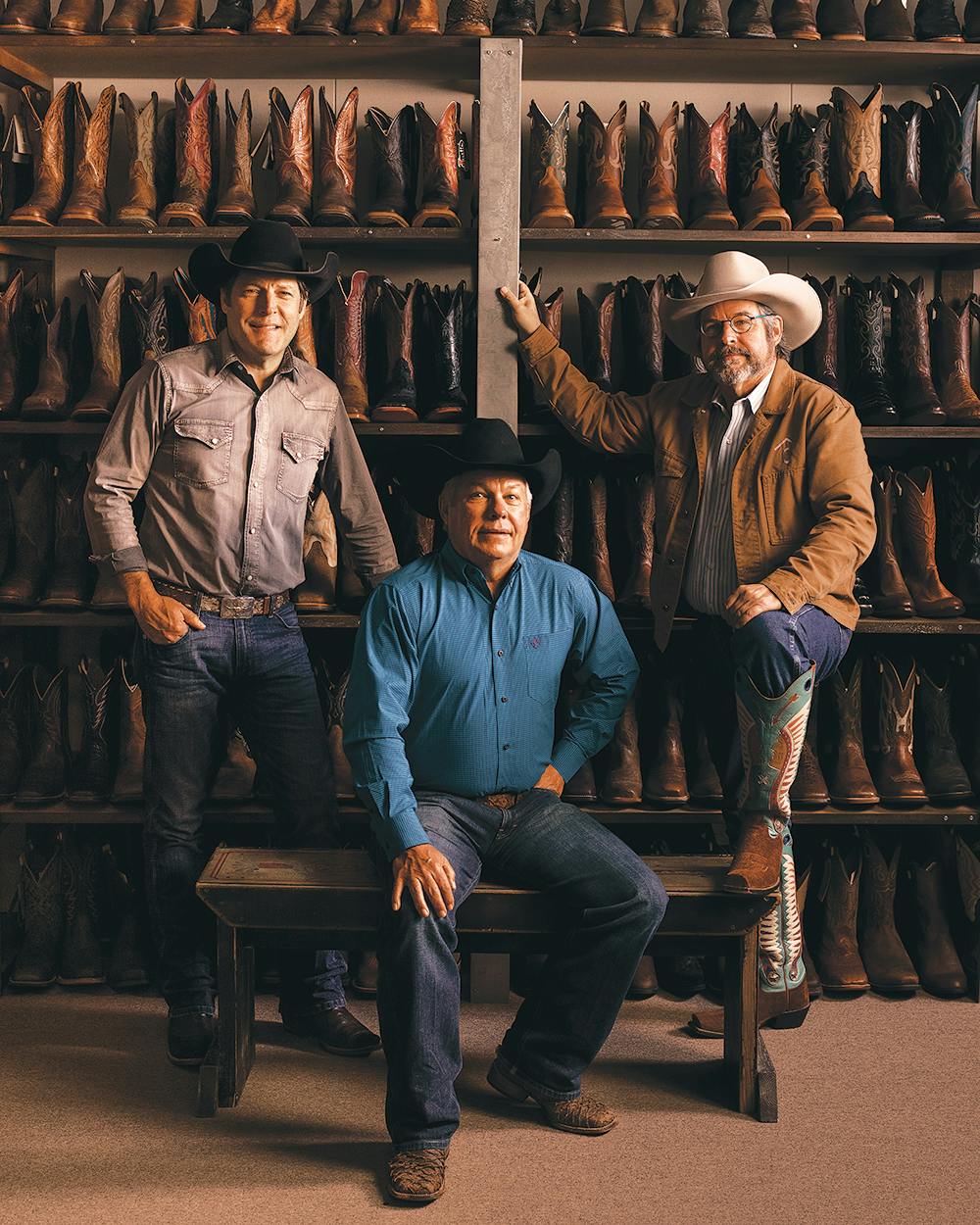
Clay, Joe, and Mike Cavender
The Hustlers
When James and Patricia Cavender opened their first store, in 1965, they couldn’t have predicted that the small Pittsburg, Texas, clothing shop would eventually become the largest privately owned Western-wear retail chain in the nation, with 83 Cavender’s locations throughout the Midwest and South, including 56 in Texas. James passed away in 2018, at 87, and Patricia this past August. Now the couple’s three sons are shepherding the business, bringing with them a lifetime of watching how Texans buy boots.
Mike Cavender: One of Dad’s big breaks came when some quail hunters out of Longview happened on the Pittsburg store around 1968. They bought a bunch of boots and started telling people in Longview about James Cavender’s good selection and prices. He started getting more and more customers. He would even load up his vehicle with boots and drive down to Longview to sell them out of his car. Word spread around East Texas. And as the years piled up, so did the stores.
Clay Cavender: Dad never met a stranger. He loved to talk to the people on the sales floor and visit.
MC: Real loud, real opinionated. But down-to-earth. And real frugal.
CC: Dad hired me one summer to work commission sales in Pittsburg, when we didn’t exactly have a lot of customers coming through the door. He didn’t like me making as much money as I did, though, so he put me in the warehouse to do warehouse work—but still paid me commission!
Joe Cavender: He was a hustler.
CC: The South is always a good market for us, but Texas is king. There’s a lot of fashion things that people wear every day in Texas that, if you go outside of the state, it might be once a month.
JC: We sell a whole lot more work boots than we did twenty years ago. Things evolve. The Urban Cowboy deal was big. Then, in the late eighties, when George Strait came on the scene, that drove another big peak in the market. There was a peak in the mid-2000s, a ladies’ boots craze. Today it’s a lot of wide, square-toed boots.
CC: I’ve got snake-proof boots for when I hunt. I’ve got everyday boots for when I go to the store. I’ve got dress boots for when I wear a suit. I used to have a pair of golf boots, believe it or not. Cowboy boots with spikes.
JC: We’re trying to get all the next generation into the business. I’ve got a son and daughter who have been in it, and we’re trying to move them up in the company.
CC: It’s definitely different without Mom and Dad. We miss them. But our plan is to continue to open three to six stores a year. There’s not a better business in the world than Western wear in Texas. How lucky are we? —As told to Emily McCullar
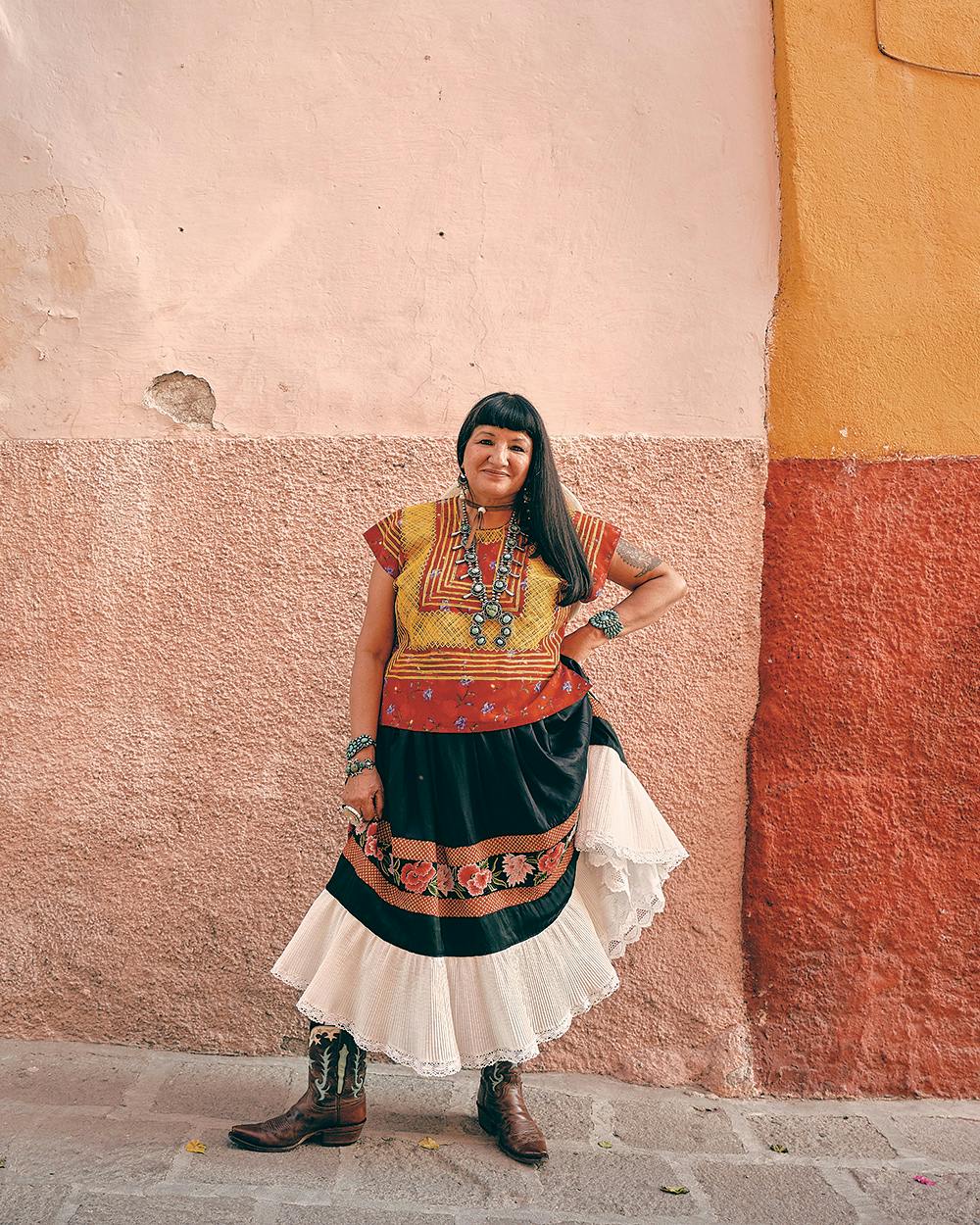
Sandra Cisneros
The Myth Buster
During the more than twenty years award-winning author Sandra Cisneros lived in San Antonio, she wrote, founded two nonprofits for writers, and made headlines for painting her King William District house “Tejano colors.” In 2013 she moved to San Miguel de Allende, Mexico.
I didn’t wear cowboy boots before I moved to Texas. And it took a long time before I started wearing them, because the way I saw them was a little bit ominous. If you’re Mexican and you think of cowboys, you think of the Texas Rangers, which is like being black and thinking of the Ku Klux Klan; you don’t necessarily have a positive association. It took me a long time to come around and understand, “Oh, wait a second, cowboy boots existed before cowboys because they come from Mexican vaquero culture. The cowboy boot is Mexican.” We forget that. There are parts of American history that we have amnesia about, and a good deal of it has to do with Mexico.
I remember going to the Rocketbuster shop, in El Paso, for the first time and seeing that a lot of the craftsmen who were making the boots were Mexican. Texas culture is built on Mexican culture, and Mexican culture is Spanish culture built on indigenous culture. If we understand that history is a continuum, then we can appreciate what came before and how it transforms us and becomes who we are.
I bought my first pair of boots around the time of the first Gulf War. I had a couple of Mexican American friends who would mix cowboy boots with vintage Mexican skirts. They would go to thrift stores in the Valley and San Antonio and South Texas and come back with old vintage skirts and vintage boots. It’s a really lovely look, and it was a very new look for me when I started emulating it.
I’m always wearing cowboy boots. I wore them to the White House and at the Texas Institute of Letters. If I’m going to travel anywhere, I always wear a pair on the plane. And if I have to go to a formal event, I always wear cowboy boots underneath my Mexican skirt. I wear them around San Miguel, but I have to have rubber added to the soles because of the sidewalks and cobblestones.
To me, what I wear is a political statement. I wear it to educate people; this is why I wore the cowboy boots and Mexican dress to the White House. I could wear anything else, but I’m always dressed in a Mexican outfit or whatever I can wear to educate the public to have pride in who they are.
I once got an award for something at the Border Book Festival, and instead of giving me a glass statue or a plaque, they were smart enough to give me a pair of cowboy boots. Isn’t that great? Wouldn’t everybody be thrilled if, for every award, instead of a plaque we got a pair of boots? Especially awards from Texas. They ought to come with a gift certificate, credit from your favorite bootmaker. —As told to Katy Vine
Bobbie Nelson
The Style Icon
Pianist, sister of Willie
The way I’m situated at the piano, you don’t see much of me except for my hat and my feet, so my footwear always seems to draw attention. I need the heel to be at an angle for the pedal. I would love to play barefoot, but it’s not comfortable. I can’t play in tennis shoes either. Sometimes a girl just needs to wear sandals. But mostly, I wear boots.

Charley Crockett
The New Outlaw
Charley Crockett is a country-blues singer from Los Fresnos and a direct descendant of Davy Crockett. He started busking at a young age, eventually touring relentlessly despite a heart condition. After two heart surgeries this past January, he released his sixth album and returned to the road.
When I was doing the street playing, I wore a lot of classic wing-tip dress shoes. Old-school New Orleans street stuff. But then, as I started spending time in Texas playing blues joints and honky-tonks, I got a pair of used Tony Lamas in East Dallas. I’d stand a little taller up there onstage.
Some of those boots that have a little higher heel, that you wear a little tighter—it’s easier to move around onstage in those if I’m doing a little boogie-woogie. I wouldn’t want to be walking down some country road in those. You need something sturdier, wider for that.
Work boots—you could hike up the side of a mountain in those damn things if you wanted to.
I’m pretty hard on them. Just wear holes right through the soles and not upkeeping them like I should be. Once your sock hits dirt? Well, you can get away with that for quite a while if it’s not raining. Just wear a thicker pair of socks.
I’ve never bought a pair of new boots. I like classic boots, the fifties and sixties boots like those old Acmes in mint condition, but it’s hard to find those. Vintage Noconas are good too. I got this pair I have right now—I think from the early seventies—that I found at this old antique mall in Asheville, North Carolina.
Softest damn leather you ever felt, these boots. They were so beautiful, didn’t have a scratch on them. The old lady working the counter, she had this whole table of dusty shoes, and those boots were the only pair among them. I thought they were at least $150. She didn’t even look over at me when I asked how much they were. She said, “Anything on that table is ten dollars.” And I just shut up and pulled out the money and got the hell out of there. I’ve been offered a few hundred for them on the street. —As told to Katy Vine
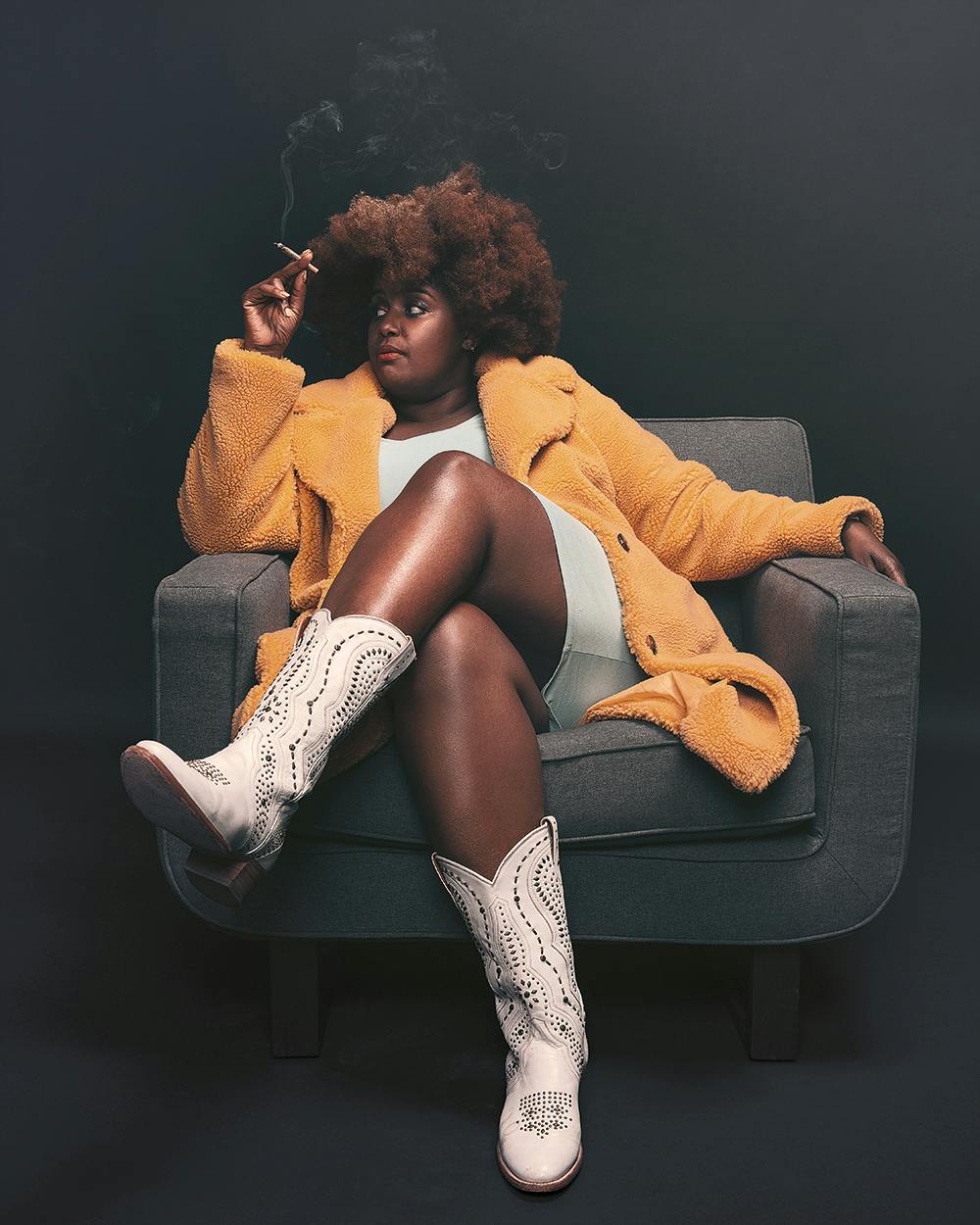
Kam Franklin
The Soul Connection
Kam Franklin is the lead singer of the Suffers, a “Gulf Coast soul” group from Houston, which formed in 2011 and has performed around the world. Franklin, who usually wears boots onstage, has worn them since she was a baby.
There was never a moment of “Oh, I’m going to start wearing cowboy boots today.” It was “Let me grab my boots,” the same way some people would say, “Let me grab my purse.” I love that they can be dressy or casual or wedding shoes. They can be anything.
When the band first started touring, Kacey Musgraves had just launched a boot line with Lucchese, and I wore her white Golden Arrow boot on Jimmy Kimmel. I went to Texas Southern University, and those boots reminded me of the majorettes at the football games performing with the Ocean of Soul marching band.
I’ve always wanted white ostrich boots. I would love black alligator too. And I have yet to find mid-calf, low-heel, red boots in my size. Size 11 women’s specialty cowboy boots are so hard to find. You get referred to men’s boots because they have more styles, which makes no sense.
Boots are a part of me and my personality. I love that I grew up where wearing cowboy boots is not considered a novelty. —As told to Katy Vine
Stephen J. “Tio” Kleberg
The Rancher
Lifelong King Ranch resident, King Ranch director, great-great-grandson of Richard King
I’ve probably owned thirty pairs of boots, and I still have all of them. Leather is a living product, and you have to keep it cleaned and oiled. You also need a boot tree. The more you wear and condition your boots, the better they feel—like a pair of gloves. If you take care of them, they’ll last you a lifetime.
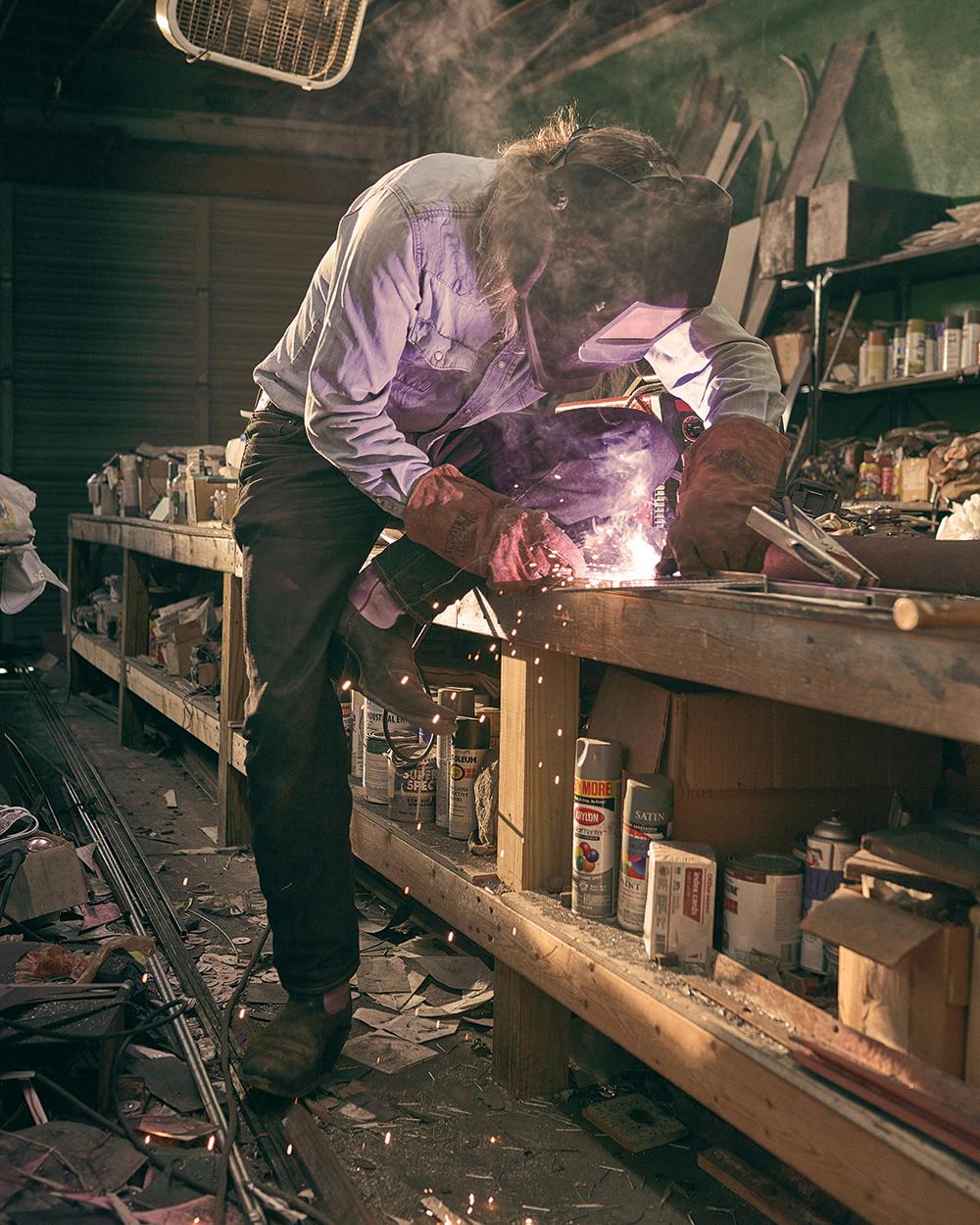
Evan Voyles
The Collector
Nobody embodies Austin’s mix of individual style and entrepreneurial spark quite like Evan Voyles, the creator of some three hundred colorful neon signs that dot the city like totems. Voyles has handmade them all, from the simple Chuy’s arrow to Home Slice Pizza’s mustachioed Queen of Pies. Before turning to neon, Voyles had another career: vintage boot collector. Once upon a time, he had what he believes was the world’s largest collection.
Growing up, my family had a ranch near Johnson City. And when you were at the ranch, you wore cowboy boots. That was just a rule.
As I got older, I started making my own choices about what I wore. It was the sixties, and my hair was getting longer. But I still wore jeans, a chambray work shirt, and cowboy boots, as I do now. At the time you were seeing rednecks wearing cowboy boots and work clothes with short hair, but you were also seeing Stephen Stills and Buffalo Springfield with long hair and muttonchop sideburns and cowboy boots.
When I went off east for college, I quit wearing boots for a year. I was at Yale. I wore khakis and button-down shirts. And I had to change back. It just didn’t fit. After that, I wore cowboy boots all the time. I was a purist. I was morally opposed to flashy boots. It was like, you need work boots and black boots, period.
By 1986, I’d left a job in San Francisco, and I was living in a Land Cruiser, driving around America. I had long hair, a beard, an earring. I arrived in Abilene, where my sister was taking care of our mom, and we went to the Buffalo Gap Flea Market. I saw a pair of boots that were black and white, with gold stars and sunflowers and butterflies. They were wild. And they were $25, which was over my budget, and they didn’t fit. I didn’t get them. But I regretted it, so we went back two days later, and they were marked down to $12.50.
They didn’t have any markings on them—no labels, nothing. I brought them home, and my mom said, “You know, there’s a bootmaker on the East Side. Maybe he can tell you something about them.” It was James Leddy. He’s dead now. But he is part of an empire of bootmakers that goes back nearly a century.
He was very kind. He explained that the boots were handmade. He said, “This is made in Mexico. See, the Mexicans do it this way. We do it this way.” And I got excited and went out and bought more boots and brought them to him. He became my mentor.
He showed me that this was a form of folk art. Cowboy boots could be identified by their architectural details in the same way that Navajo rugs could be identified by their patterns and yarn. You could date boots by style; you could place them by design.
The ground was littered with cowboy boots in the mid-eighties. They were like apples waiting to be harvested. West Texas was the biggest part of the orchard, and I went all over it, buying boots from shoe repair places and thrift stores and garage sales. I was paying, on average, $4.10 a pair.
I was a collector first. I became a dealer only to finance my habit.
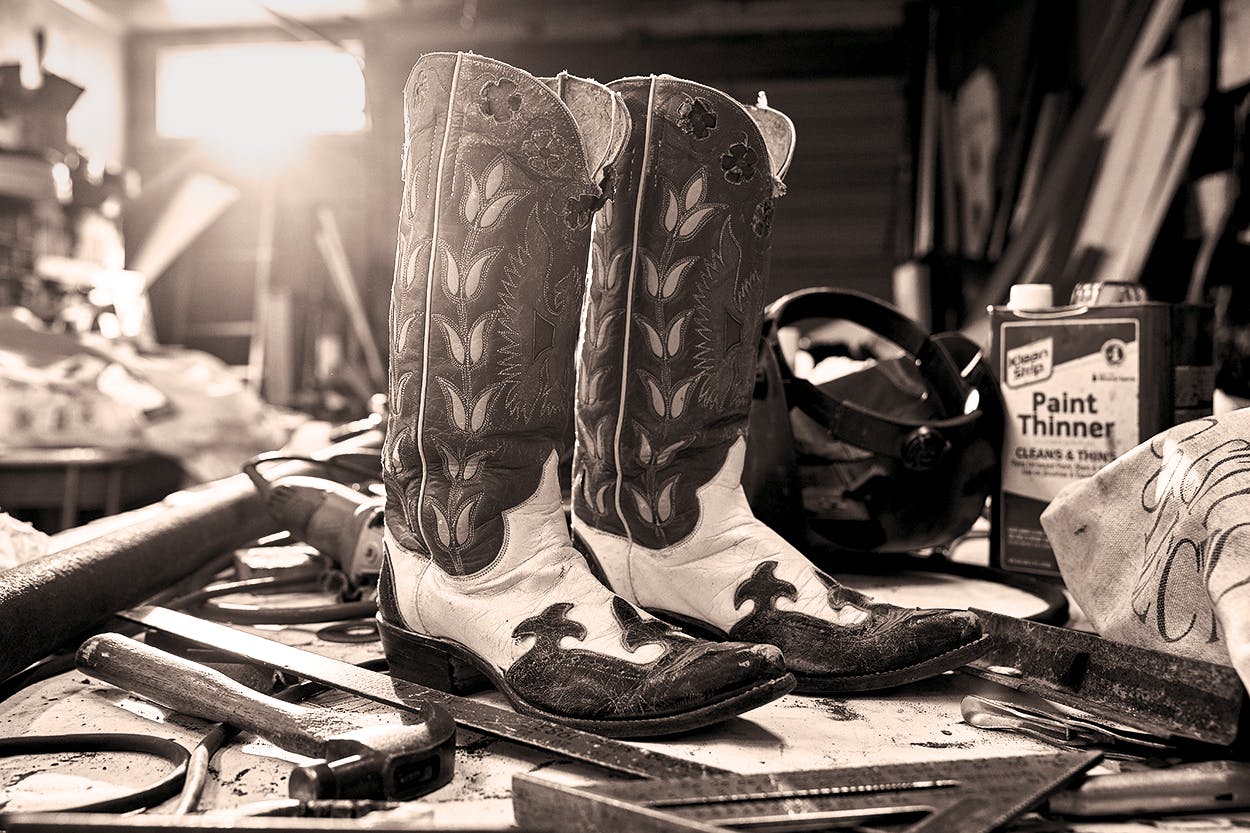
I got a storefront in Buda, filled it with cowboy boots, and opened for business, but nobody showed up. A friend told me that people in L.A. would pay good money for boots, so I would hunt my way to L.A., sell on Melrose, drive to San Francisco, and sell on Haight Street, where they’d sell for $40. Forty dollars!
One night in 1994, my storefront in Buda burned to the ground, and my entire collection with it. There were five hundred pairs. That’s when I got into the sign-making business.
I still live and work in boots the same way I always did, but now I’m closer to their purpose. When you’re climbing a ladder for work, you’ve got to have at least one hand holding something—a tool or a sign. And when you get to the top you want both hands free. The very things that make cowboy boots structurally perfect for locking into a stirrup—the pointy toe, the high instep—make them perfect for locking onto the rung of a ladder. That’s what boots are about. It’s not about style. It’s work gear.
Sometimes I’ll still see an old pair of boots sitting on a rack and go, “Oh my God, those were made by Ray Jones out of Lampasas—I’ve gotta have them!” I can’t not do it. —As told to Michael Hall
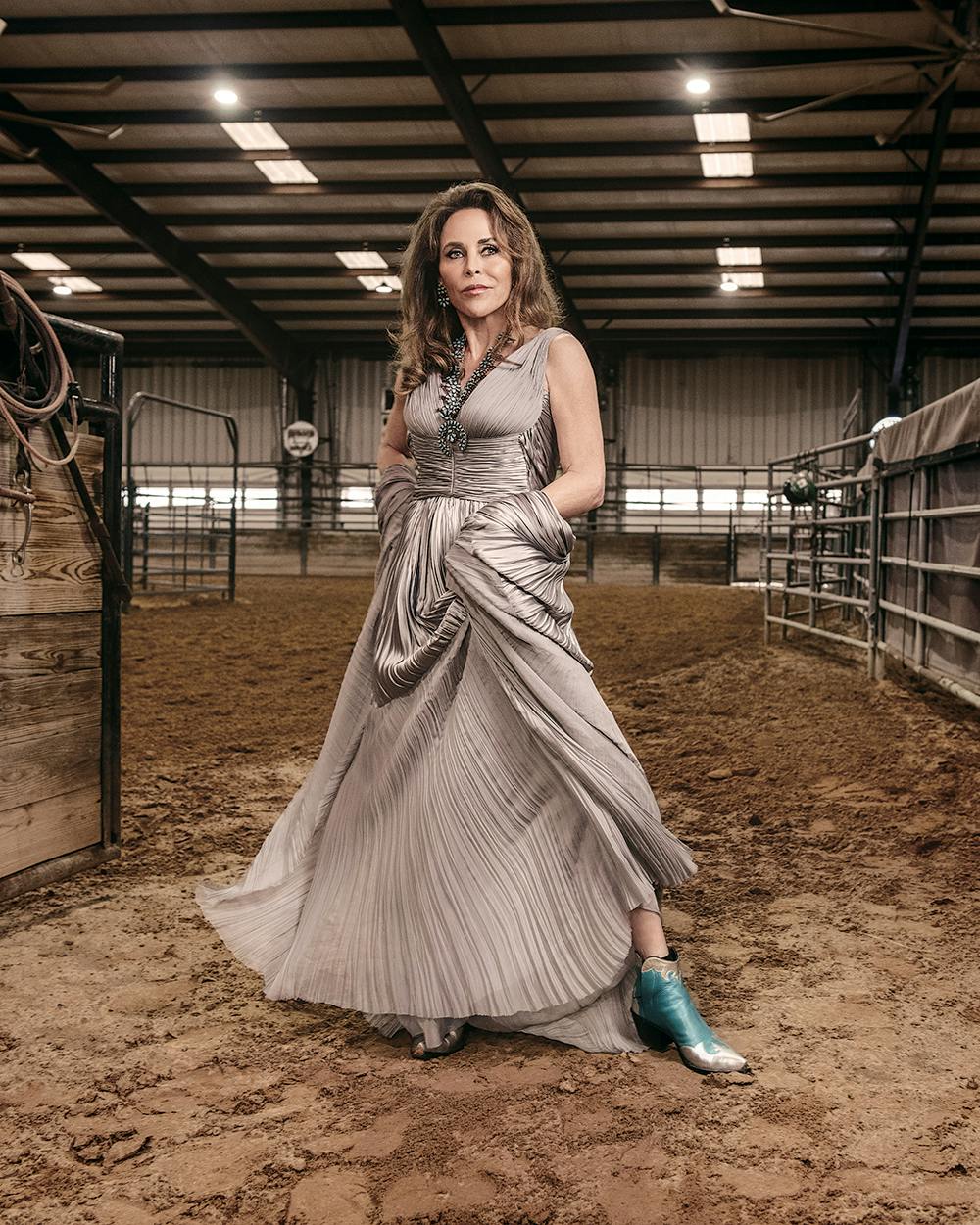
Stacie McDavid
The Socialite
Stacie McDavid is a Fort Worth philanthropist, the CEO of McDavid Companies, and a former amateur world champion in the American Cutting Horse Association. But she’s perhaps best known for her style. It’s not unusual to find her at a society party wearing couture—and cowboy boots.
I have one hundred pairs of boots in my closet—forty that I wear for riding and sixty that I call my “fashion boots.” I’ve got turquoise boots with silver tips that come up to the knee. Red boots that come over the knee. Multi-colored boots with flat heels. I’ll go to lunch wearing a T-shirt and skinny jeans tucked into zip-up ankle boots. If I’m wearing a skirt, I’ll wear pointy-toed boots.
I get up early in the morning, put on a pair of my riding boots and spurs, and go riding on our ranch outside Fort Worth. If I’m pressed for time, I’ll drive from the ranch straight to a meeting, still wearing the boots and spurs. Of course, I can only do that in Fort Worth. If I showed up to a meeting in Dallas dressed like that, people would stare and take photographs. —As told to Skip Hollandsworth
Cecile Richards
The Power User
Cofounder of Supermajority, former president of Planned Parenthood, daughter of Ann
My mom loved a good pair of boots, and now I wear them all the time too, even though I live in New York. There is never a moment when wearing boots wouldn’t have made everything go better. I probably should have worn them when I testified before Congress, now that I think about it.
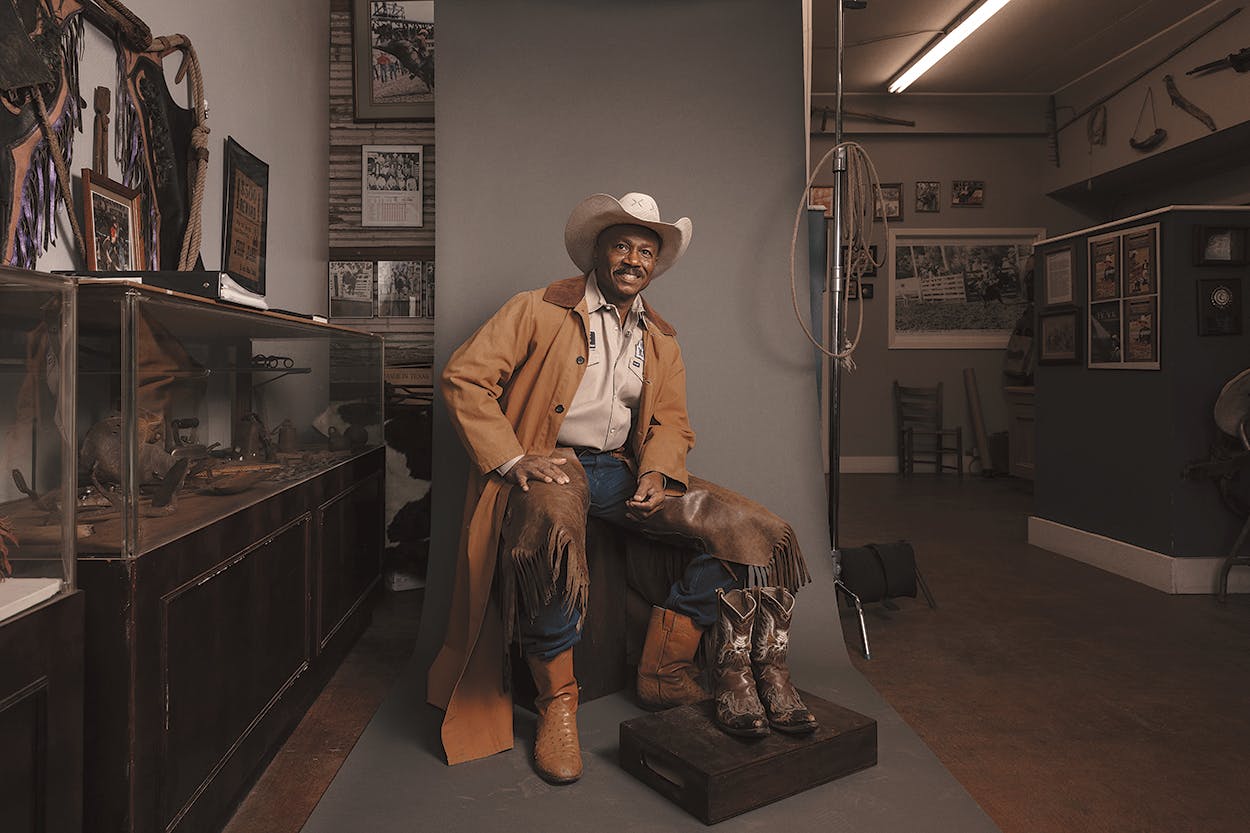
Larry Callies
The Historian
Larry Callies grew up working cattle around Boling. In 2017—after stints as a country singer, postman, and rodeo rider—he founded the Black Cowboy Museum, in Rosenberg, with the intent of reminding visitors of the role of African Americans on the frontier.
I’m one of the people that started the yeehaw agenda. They got my picture on the internet talking about my museum, how I’m influencing blacks to get into country music and cowboy culture.
I was three when I started wearing cowboy boots. My grandpa had a pair, and I wanted some just like them. I cried so much that my mom finally bought me a pair.
I got beat up quite a bit as a kid. In my grade school, I was the only black cowboy. They had never heard of a black cowboy. My brother told me if I quit wearing those boots and telling people I liked country music, they wouldn’t do that.
In junior high, I was a working cowboy doing the job of an eighteen-year-old. I also used to be a country singer and had the same manager as George Strait. I opened for Selena, for Travis Tritt. But I lost my voice in 1990. I have vocal dysfunction.
Black cowboys were the first cowboys! That’s where the word came from. Slavery. Back in 1825, at the first Jones Ranch, they had people that worked cows and people that worked in the house. They just called them “boys.” “Boy, go get this.” “That’s my cow boy.” “That’s my house boy.”
Have you ever heard of the Lone Ranger? You know he was black? He was a former slave named Bass Reeves who escaped to Oklahoma and lived with the Indians and then later became a U.S. marshal. People started telling stories about him on the radio. When they put him on TV, they knew people wouldn’t accept him as a black man, so they made him a white man with a black mask. [Editor’s note: Reeves was real, but history is unclear about whether he inspired the Lone Ranger.]
The black cowboy never stopped working. We had our own rodeos. My uncle helped start one of the first black rodeos. President of the rodeo association. We never stopped being cowboys. I quit wearing boots for a while in high school, because it was so hard. I went back to it. After I started in college, I wore boots every day. —As told to Katy Vine
